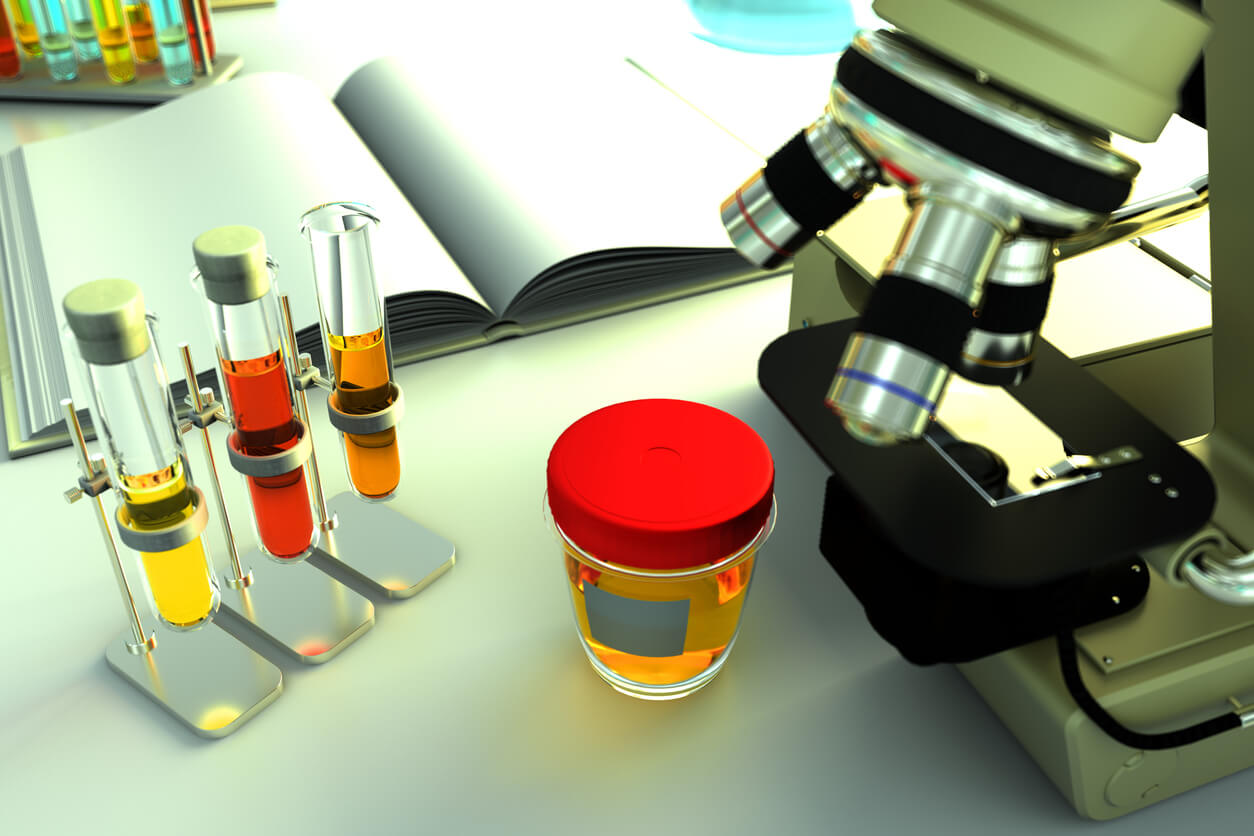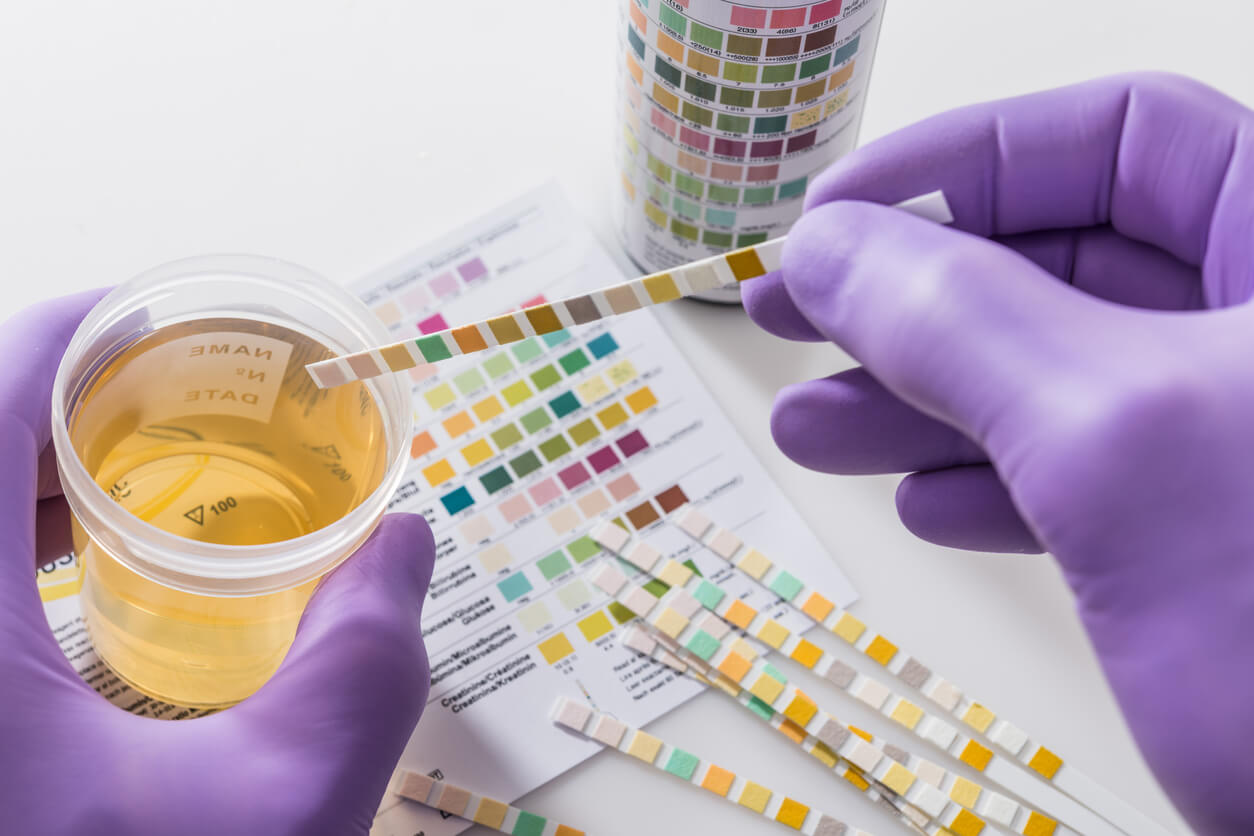Hematuria in Children: What You Need to Know

Hematuria in children is an alarming finding for parents, but it’s not always synonymous with something serious. Its causes are numerous and varied, some being systemic and others local, such as urinary tract illnesses.
The term hematuria comes from the Greek words haima, meaning ‘blood’ and ouron, meaning ‘urine’. Therefore, we can define it as the presence of red blood cells in the urine, which come from the kidney or urinary tract. In some cases, such bleeding is visible to the naked eye, while in other cases, it’s only detected through laboratory studies.
Here, we’ll tell you everything you should know about this symptom in the youngest members of your family.
What types of hematuria in children are there?
There are many ways to classify urinary bleeding and all of them allow us to know more about the origin and cause of it. Broadly speaking, we must differentiate between those cases that can be seen with the naked eye (such as a noticeable change in the color of the water in the toilet or blood in the baby’s diaper), and those that are much more subtle. The former are called macroscopic and the latter microscopic. Let’s learn more about them:
- Microhematuria: This is characterized by the presence of more than 5 red blood cells per microliter of urine and is usually a casual finding in a routine examination. To be considered significant, it must be present in more than 3 consecutive urine samples, separated by 2 to 4 weeks.
- Macrohematuria: The presence of more than 5,000 red blood cells per microliter of urine. This quantity stains the urine pink, deep red, brownish-green, or chocolate colored, depending on the concentration of red blood cells in it. It can be seen with the naked eye and should always be studied.
In turn, hematuria can be transient or persistent (when it appears for 6 months or more); initial, terminal, or postvoid (depending on which moment of urination it’s related to); glomerular or extraglomerular (depending on the origin of the bleeding).
The renal cortex contains structures called glomeruli, which perform the functions of filtering blood and producing urine. When this mechanism fails, the kidney gradually becomes diseased and this becomes evident through glomerular hematuria.

Symptoms accompanying hematuria
Bleeding in the urine is a clinical sign, which may or may not be accompanied by other manifestations. In the first case, we refer to asymptomatic hematuria, and in the second case, to symptomatic hematuria.
For the latter, the clinical manifestations will depend on the origin of the hematuria:
- When it’s a glomerular disease, the most common signs and symptoms are oliguria (a decrease in the amount of daily urine), edema, rashes, arthritis, and sore throat. Generally, there’s a history of pharyngotonsillitis that occurred a few weeks before the renal symptoms.
- Hematurias of extraglomerular origin. In these cases, the bleeding can be accompanied by the elimination of pus in the urine, pain in the lower abdomen or when urinating (dysuria), difficulty in emptying the bladder (slow stream, postvoid drip, intermittent stream), or fever.
Common causes of hematuria in children
In general, hematuria in children is usually caused by urinary tract infections (UTI), abdominal or genital trauma, and problems in calcium metabolism (hypercalciuria).
Also, the possibility of inflammatory diseases, systemic infections (such as hemolytic uremic syndrome or Serratia marcescens gastroenteritis), autoimmune conditions, metabolic disorders, or diseases involving tumors should be considered.
False hematuria in children
In addition to the pathological causes of hematuria, it’s worth noting that there are different drugs or foods that cause the urine to become darker in color than usual. They may even suggest bleeding due to the similarity in color. However, when taking a look back and what the child’s been eating and with a simple urine analysis, bleeding can be ruled out.
Here are the products that most frequently cause false hematuria in children:
- Foods: Beets, blackberries, mushrooms.
- Food pigments: Nitrogen dyes, phenolphthalein (present in laxatives), rhodamine B (in confectionery pastries).
- Drugs: Rifampicin, nitrofurantoin, metronidazole, or doxorubicin.
How to study urine when hematuria is suspected?
In most cases, a good interrogation and physical examination can guide the diagnosis of hematuria without the need to resort to complementary tests. However, urine test strips are the first choice because of their high diagnostic sensitivity and ease of implementation.

Other complementary tests
If the dipstick is positive, the results should be confirmed by a microscopic examination of the urinary sediment. This is performed on an isolated urine sample, ideally taken midstream from the first urination of the morning.
If hematuria is confirmed, the physician will proceed to request other complementary studies. For example, observation of red blood cell morphology, ultrasound, or renal scintigraphy. Also, if necessary, more precise and invasive tests such as a renal biopsy may be performed.
What follows after the diagnosis of hematuria in children?
Once the cause of hematuria in children is known, the best diagnostic strategy for each case will be determined. This may range from the use of antibiotics to immunosuppressive drug therapy.
Sometimes, after the cure, preventive measures may be implemented, such as those that seek to avoid the formation of kidney stones or the development of infections. Keeping the child well hydrated, a diet low in sodium (salt), and proper body hygiene are key to taking better care of their renal health.
The important thing is that parents are attentive to the urination of their children and that they go promptly to the pediatrician at the discovery of any sign of suspicion.
Hematuria in children is an alarming finding for parents, but it’s not always synonymous with something serious. Its causes are numerous and varied, some being systemic and others local, such as urinary tract illnesses.
The term hematuria comes from the Greek words haima, meaning ‘blood’ and ouron, meaning ‘urine’. Therefore, we can define it as the presence of red blood cells in the urine, which come from the kidney or urinary tract. In some cases, such bleeding is visible to the naked eye, while in other cases, it’s only detected through laboratory studies.
Here, we’ll tell you everything you should know about this symptom in the youngest members of your family.
What types of hematuria in children are there?
There are many ways to classify urinary bleeding and all of them allow us to know more about the origin and cause of it. Broadly speaking, we must differentiate between those cases that can be seen with the naked eye (such as a noticeable change in the color of the water in the toilet or blood in the baby’s diaper), and those that are much more subtle. The former are called macroscopic and the latter microscopic. Let’s learn more about them:
- Microhematuria: This is characterized by the presence of more than 5 red blood cells per microliter of urine and is usually a casual finding in a routine examination. To be considered significant, it must be present in more than 3 consecutive urine samples, separated by 2 to 4 weeks.
- Macrohematuria: The presence of more than 5,000 red blood cells per microliter of urine. This quantity stains the urine pink, deep red, brownish-green, or chocolate colored, depending on the concentration of red blood cells in it. It can be seen with the naked eye and should always be studied.
In turn, hematuria can be transient or persistent (when it appears for 6 months or more); initial, terminal, or postvoid (depending on which moment of urination it’s related to); glomerular or extraglomerular (depending on the origin of the bleeding).
The renal cortex contains structures called glomeruli, which perform the functions of filtering blood and producing urine. When this mechanism fails, the kidney gradually becomes diseased and this becomes evident through glomerular hematuria.

Symptoms accompanying hematuria
Bleeding in the urine is a clinical sign, which may or may not be accompanied by other manifestations. In the first case, we refer to asymptomatic hematuria, and in the second case, to symptomatic hematuria.
For the latter, the clinical manifestations will depend on the origin of the hematuria:
- When it’s a glomerular disease, the most common signs and symptoms are oliguria (a decrease in the amount of daily urine), edema, rashes, arthritis, and sore throat. Generally, there’s a history of pharyngotonsillitis that occurred a few weeks before the renal symptoms.
- Hematurias of extraglomerular origin. In these cases, the bleeding can be accompanied by the elimination of pus in the urine, pain in the lower abdomen or when urinating (dysuria), difficulty in emptying the bladder (slow stream, postvoid drip, intermittent stream), or fever.
Common causes of hematuria in children
In general, hematuria in children is usually caused by urinary tract infections (UTI), abdominal or genital trauma, and problems in calcium metabolism (hypercalciuria).
Also, the possibility of inflammatory diseases, systemic infections (such as hemolytic uremic syndrome or Serratia marcescens gastroenteritis), autoimmune conditions, metabolic disorders, or diseases involving tumors should be considered.
False hematuria in children
In addition to the pathological causes of hematuria, it’s worth noting that there are different drugs or foods that cause the urine to become darker in color than usual. They may even suggest bleeding due to the similarity in color. However, when taking a look back and what the child’s been eating and with a simple urine analysis, bleeding can be ruled out.
Here are the products that most frequently cause false hematuria in children:
- Foods: Beets, blackberries, mushrooms.
- Food pigments: Nitrogen dyes, phenolphthalein (present in laxatives), rhodamine B (in confectionery pastries).
- Drugs: Rifampicin, nitrofurantoin, metronidazole, or doxorubicin.
How to study urine when hematuria is suspected?
In most cases, a good interrogation and physical examination can guide the diagnosis of hematuria without the need to resort to complementary tests. However, urine test strips are the first choice because of their high diagnostic sensitivity and ease of implementation.

Other complementary tests
If the dipstick is positive, the results should be confirmed by a microscopic examination of the urinary sediment. This is performed on an isolated urine sample, ideally taken midstream from the first urination of the morning.
If hematuria is confirmed, the physician will proceed to request other complementary studies. For example, observation of red blood cell morphology, ultrasound, or renal scintigraphy. Also, if necessary, more precise and invasive tests such as a renal biopsy may be performed.
What follows after the diagnosis of hematuria in children?
Once the cause of hematuria in children is known, the best diagnostic strategy for each case will be determined. This may range from the use of antibiotics to immunosuppressive drug therapy.
Sometimes, after the cure, preventive measures may be implemented, such as those that seek to avoid the formation of kidney stones or the development of infections. Keeping the child well hydrated, a diet low in sodium (salt), and proper body hygiene are key to taking better care of their renal health.
The important thing is that parents are attentive to the urination of their children and that they go promptly to the pediatrician at the discovery of any sign of suspicion.
All cited sources were thoroughly reviewed by our team to ensure their quality, reliability, currency, and validity. The bibliography of this article was considered reliable and of academic or scientific accuracy.
- Carrasco Hidalgo-Barquero M, de Cea Crespo JM. Hematuria. Protoc diagn ter pediatr. 2014;1:53-68
- Cara G, Pena A. Hematuria. Actualización. An Pediatr Contin. 2009;7(2)61-9
- Vendula R, Lyengar AA. Approach to Diagnosis and Management of Hematuria. Indian J Pediatr. 2020; 87(8):618-624. doi: 10.1007/s12098-020-03184-4.
- Denver D, Reidy K. Approach to the Child with Hematuria. Pediatr Clin N Am 66 (2019) 15–30 https://doi.org/10.1016/j.pcl.2018.08.003
- Generalic A, et al. Hematuria as an Early Sign of Multisystem Inflammatory Syndrome in Children: A Case Report of a Boy With Multiple Comorbidities and Review of Literature. Front. Pediatr. 2021; 9:760070. doi: 10.3389/fped.2021.760070
This text is provided for informational purposes only and does not replace consultation with a professional. If in doubt, consult your specialist.








